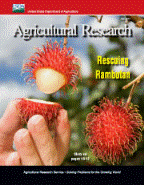United States Department of Agriculture: Agricultural Research Service, Lincoln, Nebraska

Agricultural Research Magazine
Date of this Version
7-2013
Document Type
Article
Citation
Agricultural Research July 2013.
Abstract
In western U.S. rangelands, native juniper and pinyon pine trees are spreading beyond their historical ecological niches and disrupting the environmental balance of their expanded range. Meanwhile, Agricultural Research Service scientists are teaming with university and industry colleagues to turn this problem into a source of fuel for U.S. Navy fighter jets.
“Juniper competes with grass and forbs for water and nutrients, and this leaves bare soil that is vulnerable to erosion,” says ARS scientist Mark Weltz, who works at the Great Basin Rangelands Research Unit in Reno, Nevada. “We have also lost habitat for sage grouse and mule deer, and the amount of forage available for cattle has declined as well.”
“Our options for controlling juniper expansion are limited,” adds ARS rangeland scientist Tony Svejcar, who is the research leader at the Eastern Oregon Agricultural Research Center in Burns, Oregon. “There’s not much of a market for cut juniper, so we usually just cut the trees and leave them where they fall.”
Pinyon pine trees, which in the western United States often grow alongside juniper, present similar management problems. The good news is that some preliminary estimates suggest that harvesting a percentage of these hardy trees every year could supply enough biomass to produce millions of gallons of renewable jet fuel. Removing the trees would help restore productive rangeland for livestock and protect critical sagebrush habitat for threatened species such as the western sage grouse. The time is right to develop a comprehensive strategy for harvesting the trees and using the woody biomass to jumpstart a regional biofuel industry.
Included in
Agriculture Commons, Animal Sciences Commons, Food Science Commons, Plant Sciences Commons

